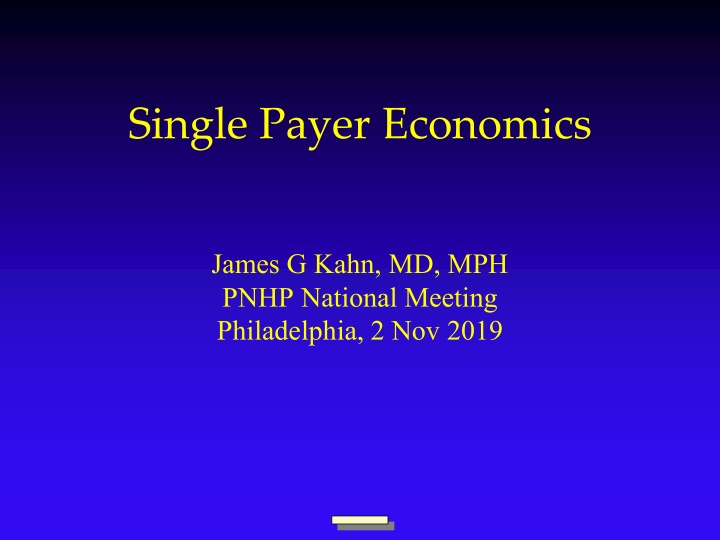
US Health Care Expenditures and Financing
Explore the complexities of US health care economics, including expenditures, financing, and comparisons with other nations. Gain insights into the multi-payer system, public vs. private financing, and factors affecting costs in the healthcare industry.
Uploaded on | 0 Views
Download Presentation

Please find below an Image/Link to download the presentation.
The content on the website is provided AS IS for your information and personal use only. It may not be sold, licensed, or shared on other websites without obtaining consent from the author. If you encounter any issues during the download, it is possible that the publisher has removed the file from their server.
You are allowed to download the files provided on this website for personal or commercial use, subject to the condition that they are used lawfully. All files are the property of their respective owners.
The content on the website is provided AS IS for your information and personal use only. It may not be sold, licensed, or shared on other websites without obtaining consent from the author.
E N D
Presentation Transcript
Single Payer Economics James G Kahn, MD, MPH PNHP National Meeting Philadelphia, 2 Nov 2019
US Health Care Expenditures Projected Type of Expenditure (billions $) 201 7 201 8 201 9 National Health Expenditures Health Consumption Expenditures Personal Health Care Hospital Care Professional Services Physician and Clinical Services Other Professional Services Dental Services Other Health, Residential, and Personal Care Home Health Care Nursing Care Facilities and Continuing Care Retirement Communities Retail Outlet Sales of Medical Products Prescription Drugs Other Medical Products Durable Medical Equipment Other Non-Durable Medical Products Government Administration Net Cost of Private Health Insurance $3,492.1 3,324.5 2,961 .0 1 ,1 42.6 920.0 694.3 96.6 1 29.1 1 83.1 97.0 $3,646.9 3,470.3 3,085.3 1 ,1 93.4 962.8 728.0 1 00.8 1 34.0 1 88.4 1 01 .8 $3,823.1 3,637.6 3,242.5 1 ,254.7 1 ,01 3.6 767.6 1 06.1 1 39.9 1 96.9 1 08.8 1 66.3 451 .9 333.4 1 1 8.5 54.4 64.1 45.0 229.5 1 70.8 468.1 344.5 1 23.6 57.4 66.2 46.7 247.2 1 78.0 490.5 360.3 1 30.2 60.9 69.3 49.4 252.0
US Health Care Financing Public 43%* (27% federal, 16% state/local) CMS (Center for Medicare and Medicaid Services) Medicare federal, aged & disabled ($502 B) Medicaid state/federal, poor & long term care ($374 B) Veteran s Admin, Military, Indian Health Svc, State and local safety net Private 34% Employers premium contribution - 21% Families premium contribution 13% Families uninsured services & cost-sharing 12% Other private 10% * Public financing = ~70% if include government employer premiums paid to PHI & tax subsidies for private insurance.
The U.S. multi-payer system vs. other nations on cost & longevity since 1974
U.S. vs Other OECD nations Spending per cap ~60% higher Generally fewer doctor visits & hospital days Difference in spending due to: price (costs of doctor, procedure, drugs) use of high technology (Dartmouth Atlas: no benefit) Billing & insurance-related admin costs (later) Weak cost controls Drugs PHI try individually, PBMs add layer / obfuscate, VA aggressive, Medicare (huge) can t negotiate by law Outpatient (RBRVS), inpatient (DRG)
U.S. Health Care Financing Multi-payer health care financing Funds Payers Providers Public & Private Many "pools" Multiple private payers & many benefit plans PPO vs capitated, many blends/variants Public: Medicare, Medi-Cal, S-CHiP, VA, Indian Health,. ~ 60 safety net programs Employer Doctors Hospitals Pharmacies Device vendors Skilled Nursing Fac. Other Premium contrib. Income taxes Out-of-pocket Admin costs of insurance 15% Admin costs overall 30%
Billing & Insurance-Related (BIR) Administrative Excess (2014) Billions How big is $400 billion in annual billing-related waste? >$1 billion per day. ~$1400 per person per year, $6000 per household All the health spending in California. Total billing-related costs Excess billing-related costs relative to single payer Jiwani BMCHSR 2014
Elements of Provider BIR Complexity of the insurance process: multiple steps, often detailed & demanding: Contracting, maintaining benefits database, patient insurance determination, collection of copayments, formulary and prior authorization procedures, procedure coding, submitting claims, receiving payments, paying subcontracted providers, appealing denials and underpayments, negotiating end-of-year resolution of unsettled claims, and collecting from patients, Discussing health insurance challenges with patients Advocating for Medicare-for-All with patients
Excess BIR in 2019 Private insurer role rising, via Medicare Advantage, Medicaid HMOs, ACA exchanges From NHE, private insurance overhead (admin, profits) = $252 billion Providers not seeing any streamlining Total est d $500 billion per year $1.5 billion per day
Comparison of M4A costing studies UCSF Medical Students & UC faculty Cai, et al not quite in press
Methods Identify models of cost of single payer (SP) proposals for U.S. (national, state) Extract SP features & analysis assumptions Extract results: Cost increase due to higher utilization from better insurance coverage Savings due to administrative simplification, drug price negotiations, other methods Net cost All as % of current spending, Year 1
Results figures removed pending publication (apologies). Summary: 19/22 studies found show net savings. Biggest savings are admin costs, followed by drug costs Look in pubmed Cai et al (soon, we hope) or email me jgkahn@gmail.com for status. -Jim
Ongoing M4A Research Maintain cost study comparison Do similar comparison for financing plans Update time by MDs on BIR Estimate impact of BIR clinical shift on net revenue Talk with MDs about payment levels under M4A Detailed online household cost calculator Assess OECD experience as guidance for U.S. M4A: How to do it right 24 Jan, Berkeley. 23 Jan work session by invitation
